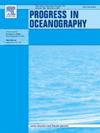Mapping internal lee wave generation and dissipation in the deep South China sea
IF 3.6
3区 地球科学
Q1 OCEANOGRAPHY
引用次数: 0
Abstract
Abyssal mixing induced by internal wave breaking has been proposed as an essential process that maintains and modulates the deep cyclonic circulation and meridional overturning circulation in the South China Sea (SCS). Previous studies have primarily focused on internal tides, leaving limited exploration on internal lee waves and their roles in mixing the SCS. This study represents the first basin-scale estimation of the lee-wave energy flux from the geostrophic flow and exploration of lee-wave-induced mixing in the SCS. Utilizing an improved spectra method with the synthetic full-scaled bathymetry, lee wave generation is estimated employing Bell theory with the outputs from the China Sea Multi-Scale Ocean Modeling System. The Luzon Strait (LS) features the strongest lee wave generation, reaching up to 19.7 GW. In the SCS interior, the total energy flux is estimated at 1.3 GW, with 70% occurring in the deep basin. In the basin area, energy flux from the mean flow surpasses that from eddy flow, whereas in the marginal area, the dominant energy flux is from eddy flow. This study reveals seasonal variation in lee wave generation, closely related to the seasonality of the deep-water overflow from the LS. The mixing driven by lee waves is found comparable with that driven by internal tides in the deep SCS basin. This study emphasizes the potentially significant lee wave energy and induced mixing in the deep SCS basin, which should be well-mapped and parameterized in ocean models for a better characterization of multiscale dynamics and energetics in the SCS.
南海深处内部背风波的产生和消散
内波破碎引起的深海混合是维持和调节南海深层气旋环流和经向翻转环流的重要过程。以前的研究主要集中在内部潮汐,对内部背风波及其在混合南海中的作用的探索有限。该研究首次在盆地尺度上估算了地转流的背风波能量通量,并探索了南海背风波引起的混合。利用改进的谱法和综合全尺度测深方法,利用Bell理论和中国海洋多尺度模拟系统的输出估计了背风波的产生。吕宋海峡(LS)具有最强的背风波产生,达到19.7吉瓦。在南海内部,总能量通量估计为1.3 GW,其中70%发生在深盆地。在盆地区,平均流的能量通量超过涡流的能量通量,而在边缘区,涡流的能量通量占主导地位。该研究揭示了背风波产生的季节变化,与浅海深水溢流的季节性密切相关。背风波驱动的混合与南海深海盆内潮驱动的混合具有可比性。本研究强调了南海深层盆地中潜在的重要的背风波能量和诱导混合,为了更好地表征南海的多尺度动力学和能量学,应该在海洋模式中进行很好的映射和参数化。
本文章由计算机程序翻译,如有差异,请以英文原文为准。
求助全文
约1分钟内获得全文
求助全文
来源期刊

Progress in Oceanography
地学-海洋学
CiteScore
7.20
自引率
4.90%
发文量
138
审稿时长
3 months
期刊介绍:
Progress in Oceanography publishes the longer, more comprehensive papers that most oceanographers feel are necessary, on occasion, to do justice to their work. Contributions are generally either a review of an aspect of oceanography or a treatise on an expanding oceanographic subject. The articles cover the entire spectrum of disciplines within the science of oceanography. Occasionally volumes are devoted to collections of papers and conference proceedings of exceptional interest. Essential reading for all oceanographers.
 求助内容:
求助内容: 应助结果提醒方式:
应助结果提醒方式:


